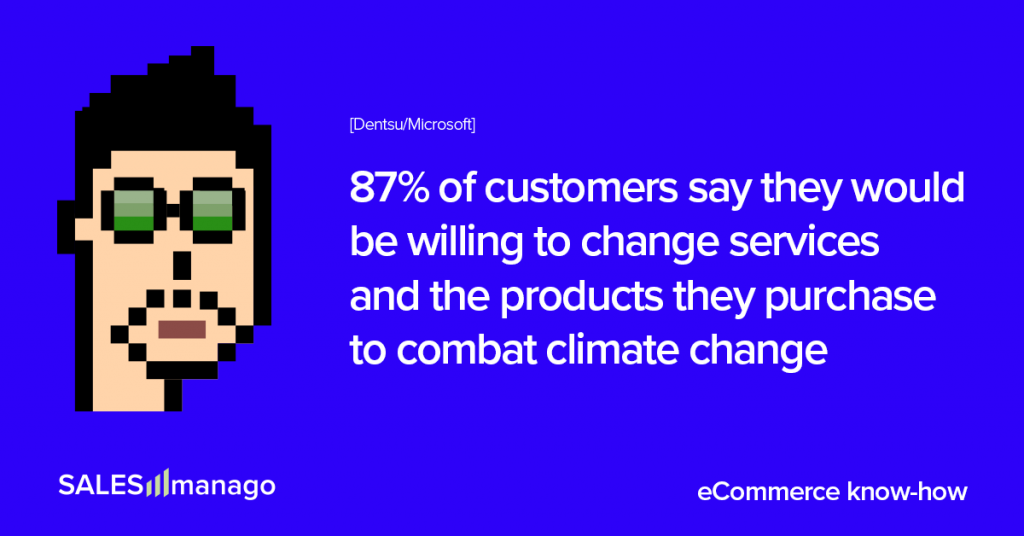
Companies’ carbon footprints have become an increasingly important issue to customers, and businesses are frantically looking for ways to reduce their size. We identified 7 ways in which zero-party data may be of help in your efforts to make your business model more sustainable—both in terms of business sustainability, and the environment. Turning your eCommerce into ECOmmerce may become one of your main advantages in 2022.
Modern CDPs make extensive use of zero-party data. Cutting-edge CDPs, such as SALESmanago, even provide features like the Customer Preference Center to collect and manage zero-party data effectively. These measures are extremely important, as zero-party data are the key to reducing a company’s carbon footprint. Furthermore, environmental sensitivity has become a major factor affecting consumers’ decisions, thus determining which brands have a bright future ahead and which are doomed to oblivion, as recent Dentsu/Microsoft research shows.
The importance of sustainability in the eyes of consumers
In August 2021, the Intergovernmental Panel on Climate Change (IPCC), the United Nations body for assessing the science related to climate change, published a report that painted a dire picture of the future if actions to preserve the environment are not taken immediately.
Inspired by the findings from the report, Dentsu and Microsoft conducted their own worldwide research project, surveying over 24,000 people from 19 countries, to understand consumer perceptions of sustainable business. The results are staggering:
- First, 86% of the study participants responded that they were concerned about climate change. In comparison, consumers revealed a similar level of concern about the pandemic (85%), the health of their friends and family (79%), and the cost of living in their area (76%). Clearly, consumers feel that climate change affects them personally.
- 88% of the respondents stated that they would make a sustainable purchase when able.
- 87% of those surveyed said they want to do more to combat climate change.
- 87% said they would be willing to change services and the products they purchase to combat climate change.
- 84% stated that they would be more likely to buy from a company practicing sustainable media advertising.
- 77% of people globally said that within five years’ time, they only want to spend money on brands that practice green and sustainable advertising.
- 81% of respondents in North America say they would stop using or buying products if they found out these products hurt the environment.
These findings clearly put extra pressure on businesses to prove their green “bona fides”
to employees, customers, regulators, and investors. Customers’ increased sustainability awareness is heightening the demand for trustworthy, robust, and transparent reporting frameworks and benchmarks to prove businesses’ credibility. Subject to reporting should be internally owned or controlled carbon emissions of a company (Scope 1) and even those outside the direct control of the business (Scope 3), such as advertising within its supply chain.
What are Scope 1, 2, and 3 emissions?
Greenhouse gas (GHG) emissions are categorized into three groups, or “Scopes,” by the most widely used international accounting tool, the Greenhouse Gas Protocol.
- Scope 1 covers direct emissions from owned or controlled sources.
- Scope 2 covers indirect emissions from the generation of purchased electricity, steam, heating, and cooling consumed by the reporting company.
- Scope 3 includes all other indirect emissions that occur in a company’s value chain.
Emissions of all scopes can be limited in various ways. As experts on customer data, we looked at the emission problem from the perspective of data management optimization to try to answer the following question:
Are CDPs able to help a company reduce emissions in all scopes? The importance of zero-party data
We found at least 7 ways in which modern CDPs have the potential to become emissions-limiting tools for carbon-conscious companies. One of the most prominent features enabling CDPs to fulfill this role is the extensive use of first-party, and – most of all – zero-party data in the process of creating an accurate and unified customer profile.
There are no data that are more accurate and relevant in the data-driven decision-making process than information passed on to the company, in goodwill, by customers, to establish preferred methods of meaningful communication with the brand.
A brand that is respectful of customers’ preferences wins their trust and gratitude. If the brand shows its readiness to listen, customers tend to respond with the same attitude. As such, zero-data-based marketing and sales processes are, therefore, more cost and energy efficient. Moreover, reliable data can be used to plan and execute more lean and efficient operations across the entire supply chain.
For this reason, we found ways to use CDP to limit CO2 emissions across all three Scopes.
CDP as a tool for a “carbon-conscious” data-driven approach for modern business
1. Zero-party data makes lean manufacturing superlean
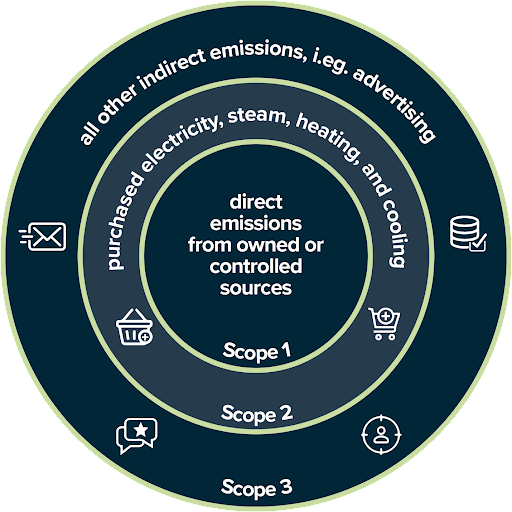
Effect: Reduction of Scope 1, 2, and 3 emissions
Lean manufacturing is a production process based on an ideology of maximizing productivity while simultaneously minimizing waste within a manufacturing operation. The lean principle sees waste as anything that doesn’t add value that the customers are willing to pay for.
What information about the market demand can be more accurate than information provided, explicitly and willingly, by customers themselves? Zero-party data massively impacts production, because it enables companies to manufacture or order only these products, for which actually exists a real market demand. And in more accurately assessed quantities. It may lead to almost zero-waste production, as well as lack of need for marketing actions like clearance sales, conducted today to cut stock costs.
This is another area of improvement, which zero-party data-driven superlean manufacturing brings to the table: even further stock costs reduction, accompanied by even further reduction of the carbon footprint.
This utilization of zero-party data effectively reduces company’s emissions in all scopes.
Customers will gladly share their favorite categories of products, types, brands, sizes, and colors with a company. Features like SALESmanago’s Customer Preference Center transform the stream of such data into clearly visible trends that help a company plan production with great precision.
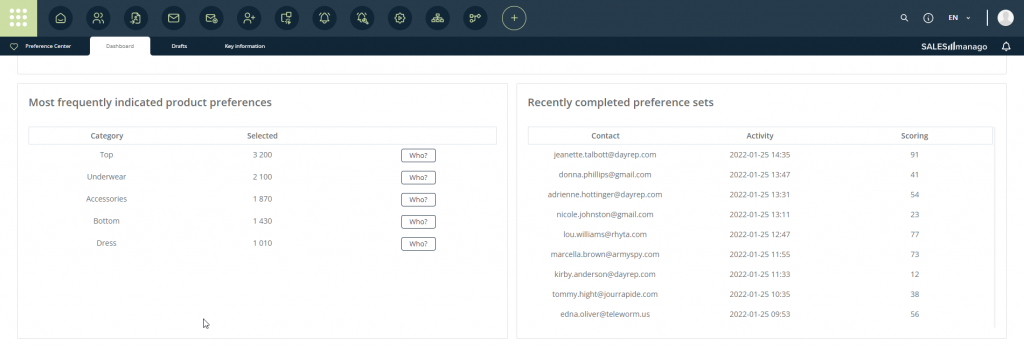
The most frequently indicatedproduct preferences in new SALESmanago’s Customer Preference Center
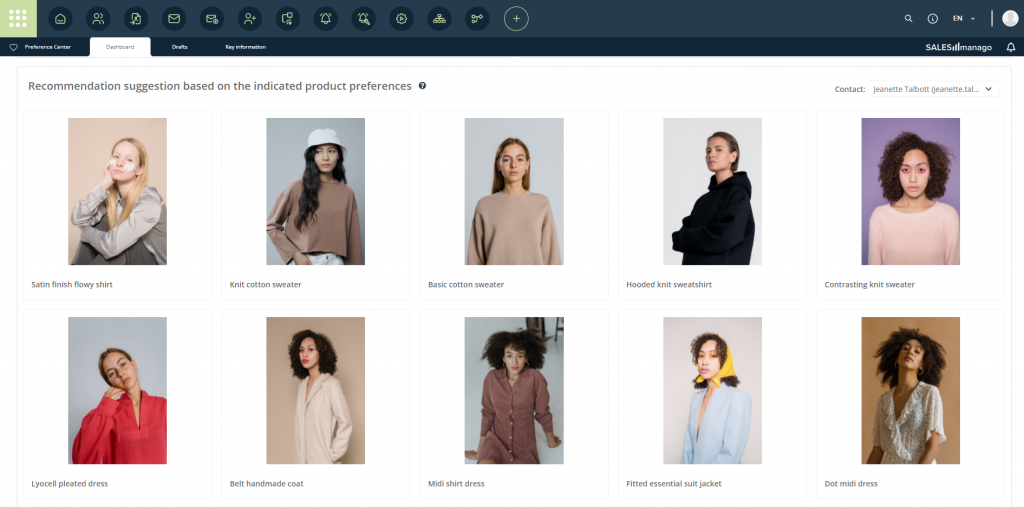
Recommendation suggestion based on the indicated product preferences in new SALESmanago’s Customer Preference Center
2. Supply chain shortening leads to emission reduction

Effect: Reduction of Scope 3 emissions
If you are a manufacturer, you may take a closer look at the Direct-to-Consumer (D2C) model of distribution. Direct-To-Consumer is an e-Commerce model, that allows companies, like manufacturers or CPG brands, to bypass the traditional chain of supply – wholesaler, distributor, retailer – and go straight to the consumer. No middlemen.
When paired with the intelligent utilization of zero-party data, D2C model leads to close, meaningful one-to-one relations with your customers.
Shortening the supply chain is by far the most effective way of reducing Scope 3 emissions – those caused by the middlemen you can’t control as effectively as your own. They simply vanish along with a part of the supply chain. It is a great example of synergy, as the emissions and costs are reduced in one move.
3. Hyperpersonalization means cleaner, “carbon conscious” marketing communication

Effect: Reduction of Scope 3 emissions
Marketing communication via traditional or even online media means communicating the company’s values to a wider audience. In fact, the very nature of non-personalized marketing communication makes a message visible to such large audiences that only a small percentage of these audiences can ever be considered a client or potential client for a company.
Furthermore, non-personalized messages, while often very creative, concentrate on the general set of values representing the brand and the product without considering the details that crucially affect a purchase decision, which is different for every customer. Traditional marketing communication is also unable to present customers with purchasing opportunities at the best possible time, such as when the lifecycle of the previously bought product comes to an end.
However, the modern Customer Data Platform provides businesses with the opportunity to generate hyperpersonalized messages for each and every eCommerce customer, taking into account their purchasing habits and preferences. All these messages go straight to actual or potential customers, so no exposition will go down the drain, and no effort will be wasted.
This means that not only is direct, hyperpersonalized communication essential to high marketing efficiency, but the energy cost of a digital marketing action can be drastically lowered. As such, hyperpersonalized marketing is much more environmentally friendly than traditional media. Furthermore, in the era of personalized marketing, 72% of consumers say they only engage with personalized messaging.
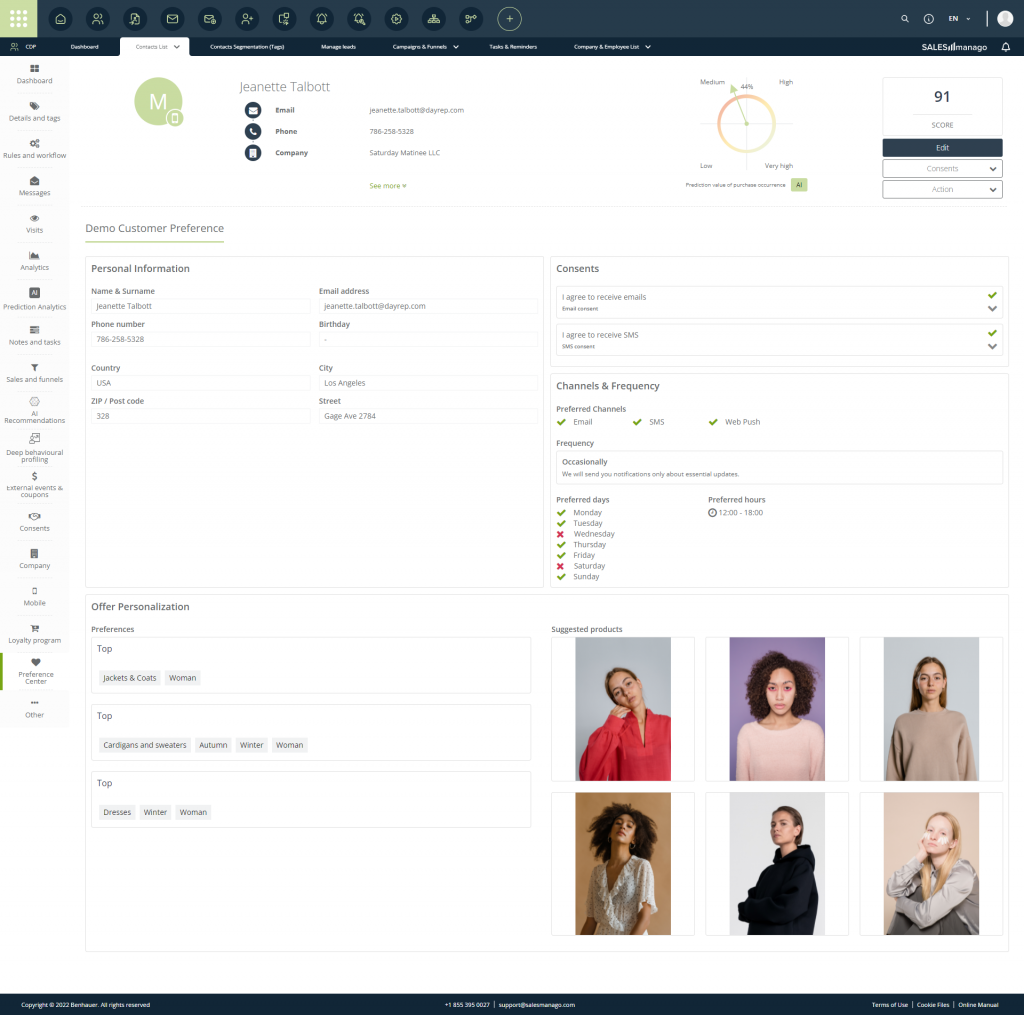
Preference Center tab in customer profile in SALESmanago CDP, created using Customer Preference Center.
4. Custom packages

Effect: Reduction of Scope 1 emissions
Intelligent use of zero-party data can help decrease the overuse of plastics in packaging.
You can simply ask customers about their preferred packaging for a shipment during the checkout process by way of acquiring zero-party data! As the majority of customers seem to be highly environmentally sensitive, most will probably choose environmentally friendly packaging. This will result in a change in your own supply structure, as your company will require significantly fewer plastic materials.
Customers would also accept the increased cost of packaging since it was their own choice to go with environment-friendly solutions.
5. Custom delivery

Effect: Reduction of Scope 3 emissions
Another way to reduce a company’s carbon print is to optimize the delivery method according to customers’ preferences.
As in the case of packaging, most environment-sensitive customers will choose deliveries to a parcel locker. This will result in a reduction in fuel consumption, as delivery people will not be forced to visit every address in the parcel locker area.

Example of questions, like delivery method, that can be asked using new SALESmanago Customer Preference Center.
6. Data-driven strategy: Fewer mistakes, reduced carbon footprint

Effect: Reduction of Scope 1, 2, and 3 emissions
Another more general way in which zero-party data may be of help in a company’s sustainability efforts is the data’s general reliability.
Strategies and decisions based on reliable data tend to be more robust and efficient. As every action undertaken by the company leaves an inevitable carbon print, the reduction of poor decisions and strategies will reduce the company’s overall negative impact on the environment.
This type of zero-party data influences the company’s emissions of all scopes.
7. Unified profiles mean less redundant data and fewer operations

Effect: Reduction of Scope 2 emissions
Creating unified, single customer profiles saves a lot of energy. In the absence of CDPs, data are often at least doubled. Storing it and conducting operations on it require electricity.
Using a unified dataset enables companies to avoid redundant operations, such as enriching two separate profiles in two or more systems with the same new data. Unified profiles are accessible to all company divisions, so all stakeholders involved benefit from each and every data operation.
3 opportunities for sustainable zero-party data use
Cost optimization
The carbon footprint is always simultaneously a money footprint. Each and every instance of energy consumption also costs money.
In this sense, every environment-sensitive solution benefits a company’s finances as well.
Staying ahead of the competition
Looking at the Dentsu/Microsoft report, it is clear that the time to act to reduce a company’s carbon footprint is now. Failing to act will negatively affect a company very quickly, as companies in virtually all industries are undertaking efforts to greenify their image and inform customers about their sustainability efforts.
Sustainable model for years to come
Carbon footprint reduction in business is a long and unavoidable process. The sooner a company sets foot on this path, the better prepared it will be for future challenges that are yet to come. After all, a sustainable financial model in a business context must first be sustainable as a vital part of the environment.
And the difference between eCommerce and ECOmmerce may soon become one of the most important factors in the customers’ purchase decision process.
 Follow
Follow
















